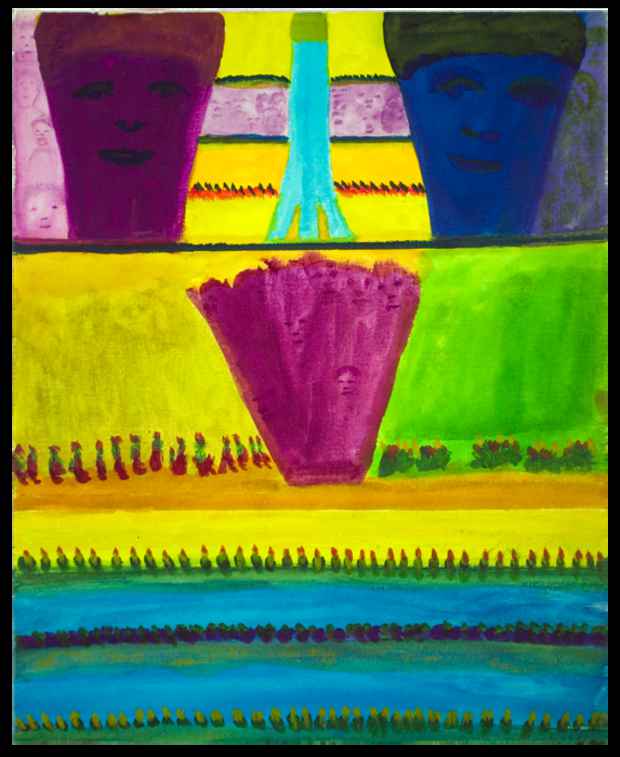David Humphrey, Austin Lee, and Agatha Wojciechowsky “Ghost in the Machine”
Life on Mars Gallery

[Image: Agatha Wojciechowsky "Untitled" (1967) Watercolor on paper. 19-3/4 by 15-7/8 in.]
This event has ended.
Life on Mars Gallery presents Ghost in the Machine, works by David Humphrey, Austin Lee, and Agatha Wojciechowsky.
Ghost in the Machine exemplifies one of our founding principles, namely, advocacy for painting’s relevance in the digital age. Ghost in the Machine draws parallels between Humphrey’s, Lee’s, and Wojciechowsky’s practices; the influences of painters from generation to generation, and between those with formal educations and those who are self-taught.
David Humphrey, a Guggenheim Fellow; exhibits widely across the United States and internationally. He debuted at David McKee Gallery, New York, NY in 1990, and is currently represented by Fredericks & Freiser Gallery, also in New York City. Humphrey’s work is in the collections of the Denver Museum, Denver, CO; the Metropolitan Museum of Art, New York, NY; the Museum of Fine Art, Boston, MA; the Walker Art Center, Minneapolis, MN, as well as many other private and public collections.
As critic and historian Raphael Rubinstein wrote in his Art in America review of Humphrey’s recent work:
“In most of the paintings, big abstract forms and explicitly figurative elements jostle alongside each other for the viewer’s attention. How are we supposed to take these collisions? Are the shapes and marks meant to be read as visual correlatives of the depicted narratives, emanations of the figures’ inner states?”
These “collisions” between the abstract and figurative, portraiture and brilliant color can be found in much of vernacular art, exemplified in works by Agatha Wojciechowsky, and in much of today’s most contemporary painting, notably the work of David Humphrey and Austin Lee.
Wojciechowsky was a well-known spiritual healer. Informed by her communication with the deceased, and with no formal art education, she began making automatic drawings in the 1950s; first, letters of an indecipherable language, then boldly colored faces and figures in surrealist landscapes. Her work was featured in solo exhibitions in New York and Europe in the 1960s and ‘70s, and group shows with Dubuffet, Duchamp, Man Ray, Noguchi, and Picabia.
Austin Lee is one of the most influential and exciting painters of his generation. He studied under David Humphrey at the Yale School of Art and received an MFA in Painting. Recent solo exhibitions include: Postmasters Gallery, New York, NY; New Galerie, Paris, France; Carl Kostyal, London, UK and Stockholm, Sweden, and Kaleidoscope in Milan, Italy. His work has been written about in Artnews, New York Magazine, Time Out New York and Time Out London, The NY Observer, Black Book, Kaleidoscope Magazine, The Spectator, and Rhizome. Lee says:
“My work is an exploration of human emotions and relationships between the digital and the physical. If my practice is a complex negotiation between different fields, I aim to keep a certain simplicity of expression and directness in experience.”
The history of painting is full of technological advancement, from Caravaggio’s and DaVinci’s use of lenses to Vermeer’s use of the camera obscura, to Degas’ use of photography. Technology aside, Austin Lee is, first and foremost, a painter. He starts by scanning a hand-made sketch; next he runs the digitized image through a 3-D modeling program, the final filter being his hand (again) using an air brush to render the output from the modeling program on traditional stretched canvas.
The title of the exhibition, Ghost in the Machine comes directly from Gilbert Ryle’s book The Concept of the Mind (1949). The book speaks of the duality of the mind–body relationship, a connection that can never actually be understood, all the while being something that is at the heart of all creative practices that engage the unconscious and leave a record of materiality. While Wojciechowsky did use the technology of her day per se, her work as a spiritualist manifested itself in ghost-like imagery. In contrast, Lee creates figures directly by using technology, from hand to computer then back to hand, expressing specifically that mind-body relationship. His figures and portraits both appear and seem to disappear all at once. In between the two in terms of technology (or, The Machine) is Humphrey’s work, with spectral and often dream-like content composed with a flatness and an aesthetic reminiscent of a screen, be it that of a computer, camera, or phone. Despite the differences in the decades in which each artist worked or their respective interest in or use of technology, there is a commonality in the longing within each artists’ work for a connection to a “humanness”- a struggle, a distance, an attempt to articulate that humanity, making the work all the more poignant - the Ghost in the Machine.
Media
Schedule
from April 15, 2016 to May 15, 2016
Opening Reception on 2016-04-15 from 18:00 to 21:00